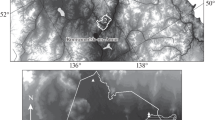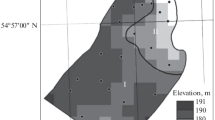Abstract
Relative elevations of different elements of the microtopography and the soil bulk density values within the 2-m-deep layer have been measured at the same points, and the relationship between these characteristics has been analyzed. It is shown that the heights (depths) of the elements of the microtopography calculated from the data on the soil bulk density agree with their actual heights (depths). The range of calculated heights (depths) is almost equal to the actual range (34 and 40 cm, respectively). A regression analysis shows that there is a close correlation between the factual heights (depths) of microhighs and microlows and the soil bulk density values (r = 0.957). The regression curve showing the dependence of the factual heights of the elements of the microtopography on the soil bulk density is very close to the regression curve showing the same dependence for the calculated heights. A change in the average bulk density of the of the 2-m-thick soil layer by 0.10 g/cm3 is accompanied by a change in the factual and calculated height of the soil surface by 12 cm. It is argued that the dynamics of the surface microtopography in the study area are controlled by changes in the soil bulk density.
Similar content being viewed by others
References
B. D. Abaturov, “Environmental Consequences of Hoofed Mammal Pasturage for Semidesert Ecosystems,” in Ecological Processes in Arid Ecosystems: XIX Lectures in Memory of Academician V. N. Sukachev, pp. 57–83 (Moscow, 2001) [in Russian].
B. D. Abaturov and L. V. Zubkova, “The Role of Little Suslik (Citellus pygmaeus Rall.) in the Formation of Hollow Microrelief and Soils in the Northern Caspian Region,” Pochvovedenie, No. 5, 59–67 (1972).
B. D. Abaturov, Mammals as an Ecosystem Component (with Herbivorous Mammals of Semideserts as an Example) (Nauka, Moscow, 1984) [in Russian].
V. S. Bogdan, Report of the Valui Agricultural Experimental Station (St. Petersburg, 1900) [in Russian].
A. F. Bol’shakov and V. M. Borovskii, “Soils and Microrelief of the Caspian Lowland,” in Transvolga Solonetzes (Akad. Nauk SSSR, Moscow, 1937), pp. 134–169 [in Russian].
A. F. Bol’shakov, “Water Regime of Soils in the Complex Steppe of the Caspian Lowland,” Tr. Pochv. Inst. im. V.V. Dokuchaeva 32, 369–396 (1950).
T. K. Gordeeva and I. V. Larin, Natural Vegetation of the Caspian Semidesert as the Food Reserve of Animal Husbandry (Nauka, Moscow, 1965) [in Russian].
N. A. Dimo and B. A. Keller, Semidesert Regions: Soil and Botanical Studies in the Southern Tsaritsyn District of the Saratov Province (Saratov, 1907) [in Russian].
E. N. Ivanova and F. Ya. Levina, “Solonetzic Complexes of the Caspian Region,” Pochvovedenie, No. 10, 907–919 (1952).
E. N. Ivanova and V. M. Fridland, “Soil Complexes of Dry Steppes and Their Evolution,” in Problems in Improving the Food Reserves in Steppe, Semidesert, and Desert Zones of the USSR (Akad. Nauk SSSR, Moscow, 1954), pp. 162–190 [in Russian].
A. A. Izmail’skii, Soil and Ground Water in Relation to Local Topography and the Cultivation Status of Soil Surface (Poltava, 1894) [in Russian].
L. I. Iozefovich, “Microrelief Genesis and Dry-Steppe Complexes,” in Nature and Agriculture of Droughty-Desert Regions of the USSR (Voronezh, 1928), No. 3, pp. 113–148 [in Russian].
I. V. Kamenetskaya, “Natural Vegetation of the Dzhanybek Research Station,” in Proceedings of the Complex Scientific Expedition on Agricultural Afforestation (Akad. Nauk SSSR, Moscow, 1952), Vol. 2, pp. 101–162 [in Russian].
S. S. Neustruev, “About ‘Normal’ Soils and Zonality of a Dry-Steppe Complex,” Pochvovedenie 12(2), 177–190 (1910).
G. N. Novikov, “Plant-Soil Complexes in the Northern Caspian Plain, Their Types, and Genesis,” in Vegetation of the Caspian Lowland (Akad. Nauk SSSR, Moscow, 1936), Vol. 1, pp. 36–176 [in Russian].
A. A. Rode, “Microrelief Genesis of the Caspian Lowland,” Vopr. Geogr. No. 33, 249–260 (1953).
A. A. Rode and M. N. Pol’skii, “Soils of the Dzhanybek Research Station, Their Morphology, Texture, Chemical Composition, and Physical Properties,” in Semidesert Soils of the Northwestern Caspian Region and Their Reclamation: Proceedings of the Dokuchaev Soil Science Institute (Akad. Nauk SSSR, Moscow, 1961), Vol. 56, pp. 3–214 [in Russian].
I. G. Rozmakhov, “Development of Solonetzic Complexes,” Tr. Pochv. Inst., Akad. Nauk SSSR 22(1), 31–89 (1940).
F. P. Savarenskii, “Hydrogeological Outline of the Transvolga Region,” in Selected Works (Moscow, 1950), pp. 48–106 [in Russian].
I. D. Sedletskii, “Little Steppe Depressions,” Priroda, No. 3, 86–87 (1954).
P. A. Tutkovskii, “Fossil Deserts of the Northern Hemisphere,” in Supplement to Zemlevedenie (Land Science) of 1909 (Moscow, 1910) [in Russian].
N. I. Usov, Genesis and Reclamation of Soils in the Caspian Lowland (Saratov, 1940) [in Russian].
A. M. Shvyryaeva, “Evolution of Plant Cover in Dark-Colored Depressions of a Binary Complex,” Sov. Bot., No. 2, 20–29 (1939).
Author information
Authors and Affiliations
Additional information
Original Russian Text © B.D. Abaturov, 2007, published in Pochvovedenie, 2007, No. 7, pp. 831–837.
Rights and permissions
About this article
Cite this article
Abaturov, B.D. Soil bulk density as a factor of the microrelief formation in semideserts of the north Caspian region. Eurasian Soil Sc. 40, 747–753 (2007). https://doi.org/10.1134/S106422930707006X
Received:
Issue Date:
DOI: https://doi.org/10.1134/S106422930707006X




